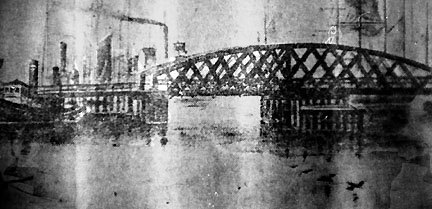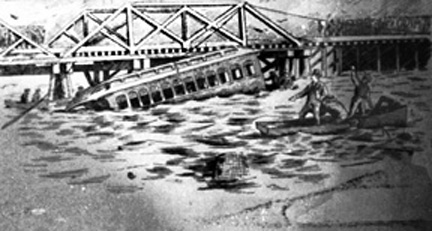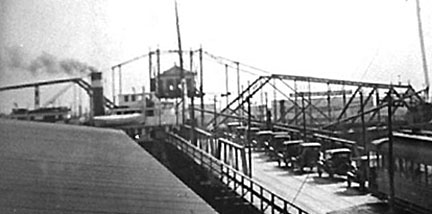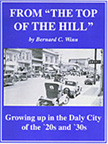INCLINE PRESS
2 Townsend St., 2-213
San Francisco, CA 94107
(415) 284-0127
|

|

|
|
|
SAN FRANCISCO PHOTOS
|

|

|
|
|

|
|
|

|
|
|

|
|
|

|
|
|

|
|
|

|
|
|

|
|
|

|
|
|

|
|
|
BOOKS
|

|

|
|
|

|
|
|

|
|
|

|
|
|

|
|
|

|
|
|

|
|
|

|
|
|

|
|
|

|
|
|

|
|
|

|
|
|

|
|
|
NON-SAN FRANCISCO PHOTOS
|

|

|
|
|

|
|
|

|
|
|

|
|
|

|
|
|
OTHER STUFF
|

|

|
|
|
|

|

INCLINE PRESS: The Alameda Connection #1
|

|
|

|

|


OAKLAND <<——>>ALAMEDA
DRAWBRIDGES
Since not everyone is familiar with drawbridges, I offer the following explaination: A drawbridge is any bridge with the capacity to move a section of its roadway to allow or prevent water vessels from passing through. The moveable section may lift straight up (vertical lift); rotate180 degrees (swing); float out of the way (pontoon); lift up from one end (bascule); fold away (folding); slide away horizontally (retractable). Also, unlike "fixed" or "rigid" bridges, drawbridges are machines and are subject to regulations that apply to both their roadway and the waterway they span. The terms drawbridge and moveable bridge are interchangeable.
Nowhere else in California have drawbridges been so plentiful or played so important a role as in the Oakland-Alameda area.
Until 1903, Alameda was a peninsula extending northwesterly from San Leandro. In that year, the U.S.Corps of Engineers dredged a channel between the end of the tidal estuary to San Leandro Bay, making Alameda an island. The entire channel was not navigable until approximately 1911.
At least 19 moveable bridges have spanned San Antonio Creek, its estuary, and San Leandro Bay. A small bridge, built across San Antonio Creek at Twelfth Street to join Oakland and Clinton (East Oakland) in 1853, is the earliest recorded drawbridge in California.
San Antonio Creek emptied into the Estuary about where Laney College is today and schooners navigated the creek to load lumber and hides at the embarcadero on the north shore of Lake Merritt.
The Twelfth Street Bridge, which consisted of little more than a wooden trestle and a hand-operated bascule drawspan, was a very troublesome and, also very expensive bridge for several years.
In 1865 the San Francisco-Oakland Railroad built a drawbrridge of undetermined type, over the creek at Seventh Street, between Fourth and Fifth Avenues. There are no photos of either of these bridges to my knowledge
Navigation on San Antonio Creek ended in 1869 when the Western Pacific Railroad received permission to build a fixed bridge across the mouth of the waterway.
The FIRST of the four Webster Street drawbridges to span the Oakland Estuary between Oakland and Alameda, was built in 1871. A simple trestle bridge with a 200-foot swing span, it lasted until 1880, when the South Pacific Coast Railroad obtained the rights to it and tore it down.

Shown above is a scrapbook snapshot of the first drawbridge to span The Oakland Estuary at Webster Street. Oakland Library photo.
A year later, in 1881, the SECOND Webster bridge was completed. That bridge, which had three trusses and a manually operated swing span, carried two lanes of vehicular traffic and tracks for the company's narrow gauge railroad. After seventeen very hard years of service with a number of mishaps, some very serious, it was removed. The swing span survived to become the moveable span on the third Bay Farm Island Bridge in 1898.

Above. On may 19, 1890, thirteen people were killed when a train traveling from Alameda to Oakland, plunged into the estuary from the second Webster Street Bridge. The engineer missed the signal warning him that the swing span was open. Alameda Library photo.
After two years without a bridge at Webster Street, the THIRD Webster Street Bridge was completed and opened for road traffic in February of 1900. The all steel span, with a 40hp engine to operate the swing span, became the first electrically powered bridge on the estuary. Its wooden roadway carried a single set of tracks to be used by both streetcars and trains.
This bridge, which had already seen more than its share of mishaps and accidents on that busy waterway, was destroyed when rammed by the steamer Lancaster on January 7, 1926. The the swing span, the most important part of a swing bridge, was off its pier and into the estuary. Because "the Posey Tube," the vehicular tube under the estuary, was not sceduled to be completed until 1928, work was soon started on a "new" bridge.

Above. The Third Webster Street Bridge after being struck by the S.S. Lancaster. Alameda Library photo.
Opened to traffic on August 17, 1926. The the FOURTH and last bridge across the estuary at Webster Street had a short but eventful life as did those before it. Less than a year after it was opened, it was closed to surface traffic for a month due to having been struck by the SS Diane Dollar. The ship reached the bridge before the span had time to open.
Shortly after the Posey Tube opened in 1928, the fourth Webster bridge was closed, and auctioned off to the highest bidder.

The above scene of the fourth and last Webster Street bridge was captured in November of 1927. Oakland Library photo.
There was a fifth Webster Street Drawbridge, but it didn't span the estuary so isn't counted along with the other four.
Due to an unusual situation brought about by the construction of a second tube under the estuary, a fifth drawbridge was build at Webster Street in 1960. Unlike the four that spanned the estuary, this one, a vertical lift bridge, was parallel to the estuary and spanned a channel that extended from the estuary to a spot near Marina Village Parkway.
No photo is available.

|

|
|





